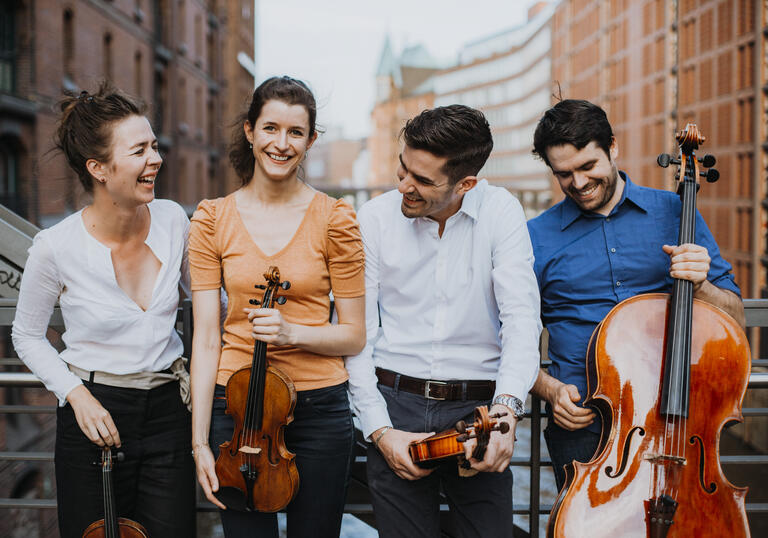The humble string quartet holds the universe in its notes. Those four lines, simple or complex, sit flat on a page in wait for the players to lift their instruments and bring them to life – the more history and humanity the quartet brings to the piece, the better. There are so many things to balance in a quartet: the fragility of the snaking individual parts and the potential robustness of the group as a whole; the complexity of relationships and the history of the works themselves; the freshness that a group can bring and the significance of recordings that audiences know and love.
Performing in a quartet involves a constant, living conversation with the composer, the audience and each other. The late, celebrated English conductor Jeffrey Tate once said that ‘the most perfect expression of human behaviour is a string quartet’, and, indeed, the form, which walks a tightrope of intimate and orchestral, comes very near to ideal. Composers throughout history have revelled in the joys and tussled with the trials of creating for such an ensemble.
Joseph Haydn was the creator of the string quartet as we know it today, and wrote prolifically for the medium. His Op 76 consists of six works written around 1797–8. Now in his sixties, he was still supremely busy at this time, in the employ of the court of Prince Nicolaus Esterházy II and juggling numerous significant projects, including his oratorio The Creation. The six quartets are innovative and ambitious, existing in a space outside of the standard sonata form to create something that sounds continuously fresh when performed today. The English music historian Charles Burney, who had a long and fruitful friendship with Haydn, praised them for their innate creativity: ‘they are full of invention, fire, good taste and new effects, and seem the production, not of a sublime genius who has written so much and so well already, but of one of highly-cultivated talents, who had expended none of his fire before.’ The Second Quartet in D minor which we hear today is nicknamed Fifths for the interval of a falling perfect fifth that opens the work; it’s a serious musical accomplishment, with Haydn demanding the full attention of his listeners as he revels in the sublime combination of compositional artistry and emotion.
Bringing us into the 21st century is Misato Mochizuki’s in-side, a work that takes the idea of the traditional quartet – a reflection of the human – and extends it, using the four instruments as tools to explore research on brain function. This is a concept that fascinates her, and this quartet is the fourth in a cycle called Brains. In in-side she focuses on studies that suggest that rhythm and melody stimulate different areas of the brain, therefore suggesting that different parts of the brain are characters, observing each other and, as Mochizuki puts it, allowing those parts ‘manage to imagine, to anticipate and even to participate in the realisation of the behaviours of others, by a process specific to the functioning of the brain called “sympathy”.’ Her piece also takes inspiration from ancient Japanese interpretations of the genesis of the world and the way in which the first deity creates a second entity as an ‘alter-ego’. As Mochizuki explains: ‘It is from the harmony of these two beings that will subsequently be born the many spirits linked to the Japanese cosmogony. I took up this image in my piece, where a kind of note contained in the percussive ostinato of the cello (“alter-ego”) will be gradually revealed by a drawn-out, vibrated note in the second violin. This vibration … becomes both a “melody” taken up by the viola and glissandos played on the first violin.’
The exchange between the selves continues in Felix Mendelssohn’s String Quartet No 6, his last major work before his premature death in 1847. His sister, the equally talented composer and pianist Fanny Mendelssohn, had died earlier that year from the devastating complications of a stroke, and it’s thought that Felix wrote this quartet in homage to her. The work is a dark one – full of bristling textures and stormy tremolos. While the intensity of the opening movement eventually calms, there’s a sense of restlessness throughout the remaining three, whether energetically sprinting or prayerful, but always with a deep undercurrent of melancholy. It’s hard to know whether this piece was a reflection of Mendelssohn’s pain in losing his sister, or whether he was exploring a new facet of his compositional technique – one that he tragically never got to expand upon.
The string quartet, as we hear today, is so much more than the sum of its parts, representative of many lifetimes of music making and creativity, and relationship building and disintegration and rebuilding. It is nothing less than, in Goethe’s words, a ‘civilised conversation between four independent personalities’. Long may the conversation continue.
© Megan Steller

